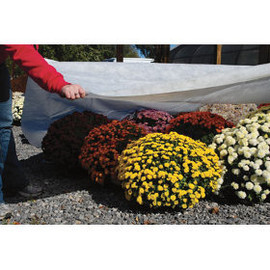
Call us toll free today 800.635.3621
 Winter will be here soon and now is the time to begin thinking about how to prepare your garden for the cold months ahead. Taking the time to prepare now will help your plants grow healthy and strong in the spring.
Winter will be here soon and now is the time to begin thinking about how to prepare your garden for the cold months ahead. Taking the time to prepare now will help your plants grow healthy and strong in the spring.
It is important to spread out a thick layer of mulch on the ground and around your plants. This will keep the temperature consistent throughout the winter.
To prepare your perennials for the winter, trim dry stems to soil level to clean up the garden and remove pest eggs and disease spores. Leave stems with attractive seed heads. Compost dead plant debris. Discard diseased foliage from evergreen plants and shrubs. Rake up and discard old mulch. Add a 6-inch layer of organic mulch after the ground freezes. Use pine needles or chopped leaves for perennials and shrub beds.
Use evergreen boughs to mulch your bulb beds. This will prevent the soil from shifting and cracking.
Protect the bark of young trees from animals with wire or commercial tree-guard products. Shield evergreens from the sun with burlap screens or shade cloth shelters.
Stop fertilizing your roses in late summer and stop feeding them two months before you expect the first frost. Don't do any major pruning, and stop cutting blossoms. This will prevent new, tender growth that would be killed by the first frost.
Remove old mulch from around the roses and replace it with wood chips, shredded bark, or chopped leaves before the first hard frost. If rodents are an issue, wait until the ground freezes. Water the roses well.
After the ground freezes, add more mulch. For rose trees, surround them with four stakes, wrap burlap around the stakes, and fill it in with shredded leaves. Protect low rose bushes with cylinders made from cardboard, metal, or plastic or foam rose cones filled with shredded bark, paper, or leaves. Protect grafts (bud unions) and crowns of roses with loose soil, wood chips, shredded bark, or shredded leaves piled a foot high. Wrap climbing roses with burlap or lay them horizontally on the ground and cover them with leaves, wood chips, or soil.
Leaf mold will promote healthy soil by improving its texture, creating air spaces in the soil that allow roots to penetrate, improving the soil's ability to absorb moisture, creating populations of microbes that improve the soil's fertility, and allowing earthworms to thrive and convert the leaves to nutrient-rich castings.
To create leaf mold, set up a wire cylinder or other container, shred leaves, and use them to fill the cylinder. Damp leaves will decompose faster. Use the leaf mold as organic mulch to prepare your garden for the winter.
Fall is the time to begin to prepare your garden for the colder weather that will be coming soon. Taking the right steps now can help your garden flourish next spring.
Check More of Our Gardening Tips


